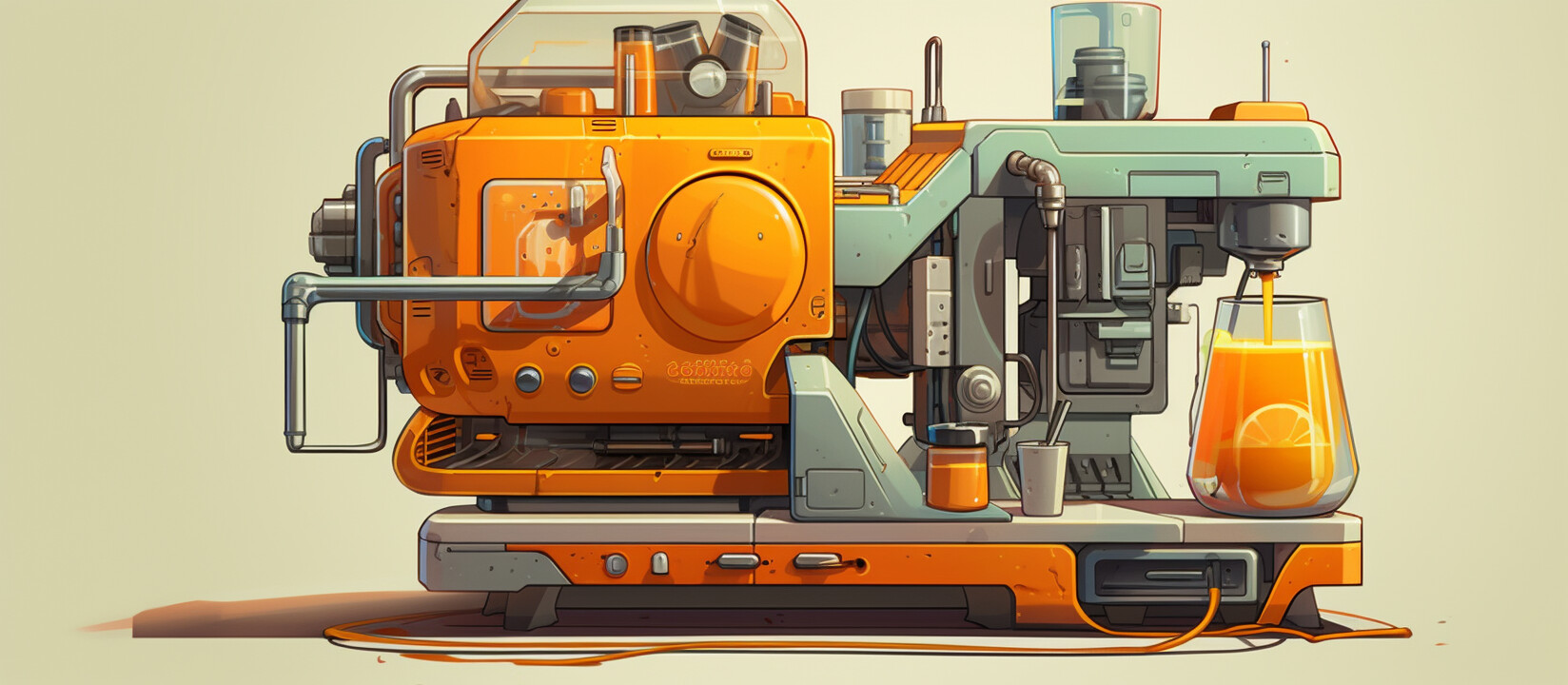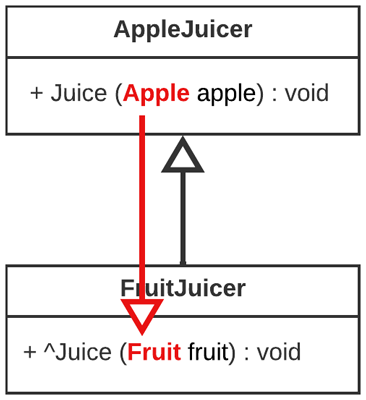109. Contravariance#
After diving into the topic of variance and having introduced covariance, it’s time to explore another form of variance: contravariance.
Key point
If you ask for a machine that produces juice from apples and I give you a machine that produces juice from any fruit then you shouldn’t be upset.
Imagine that you were expecting a machine that produces juice from apples but get a machine that produces juice from any fruit. If you were to feed only apples into this machine, it would function as well as an apple-specific juicer. This illustrates the concept of contravariance.

Fig. 109.1 Just like a fruit juicer can substitute an orange juicer, contravariance inverts the natural hierarchy of types.#
If the type of input that the machine can process is contravariant, then a more general fruit juicer is a subtype of a more specific apple juicer. In other words, the more general machine can substitute the more specific machine. Let’s dissect what this means.
Tip
Try to focus on whether something can substitute something else, rather than whether something is something else.
Understanding contravariance with generic delegates#
In covariance, we saw that a more specific type can substitute a more general type. Contravariance flips this idea on its head.
If a generic type I is parameterized over the type parameter T, denoted as I<T>, and if T is contravariant, then the usual ordering of types is inverted.
This means that subtypes may use more general types than what’s used in the supertype.
For example I<Fruit> would actually be a subtype of I<Apple> if Apple is a subtype of Fruit.
Definition
If A is a subtype of B and if T is contravariant in I<T> then I<B> is a subtype of I<A>.
Let’s utilize generic delegates to delve deeper into contravariance.
Suppose that we have the two classes Apple and Fruit and that the former is a subtype of the latter.
class Fruit {}
class Apple : Fruit {}
In the following example, a variable of type Action<Apple> is assigned a delegate instance of type Action<Fruit>.
This code compiles because Action<Fruit> is a subtype of Action<Apple> which means that the type can be implicitly upcast.
It is a subtype since T is contravariant in Action<T> and Apple is a subtype of Fruit.
Action<Fruit> fruitJuicer = (Fruit x)
=> Console.WriteLine("Turning fruit into juice");
Action<Apple> appleJuicer = fruitJuicer;
Why is this compile-time type-safe?
An Action<T> is a delegate whose values must all be functions or methods that take a T as input.
To determine whether a substitution is type-safe we consequently only need to care about whether any input that can be given to the supertype (Action<Apple>) also can be handled by the subtype (Action<Fruit>).
Tip
The generic delegate Action<T> is essentially a ‘consumer’ of elements of type T. It takes them as input but never produces them as output.
When you define an Action<Apple>, you are saying you need a function that can take objects of type Apple as input. An Action<Fruit> meets that requirement because it can take any Fruit as input, which of course includes Apple since that’s a subtype of Fruit. Therefore, it is type-safe to assign Action<Fruit> to Action<Apple>.
Understanding contravariance with classes#
Let’s now also explore how contravariance would work in the context of classes. Unlike with generics and unlike with covariance, C# does not support contravariance in classes. More on this in the chapter on variant classes. However, we can still use classes to understand the concept of contravariance theoretically.
In the hypothetical code below, the class FruitJuicer inherits from the class AppleJuicer and overrides the method that juices its input.
class AppleJuicer
{
public virtual void Juice(Apple apple)
=> Console.WriteLine("Turning apple into juice");
}
class FruitJuicer : AppleJuicer
{
// The following override is theoretical and won't compile in C#.
public override void Juice(Fruit fruit)
=> Console.WriteLine("Turning fruit into juice");
}
The method signature in the super class is Juice(Apple apple) while the method signature in the subclass is Juice(Fruit fruit).
If C# would support contravariant method parameters then this would compile.
The subtype’s method could accept a more general type than what’s used in the supertype.
Note
Why is it type safe? The Juice method in both AppleJuicer and FruitJuicer acts as a ‘consumer’ of elements, similar to certain methods in contravariant interfaces like IComparer<T>. These methods consume elements of a specific type as input but don’t produce any elements of that type as output. This is why it’s type-safe to have contravariant method input parameters.

Fig. 109.2 This UML class diagram is annotated with a red arrow to highlight the concept of contravariance. In contrast to the usual type hierarchy of the method parameters, where Apple is a subtype of Fruit, the arrow between the containing types follows an inverted hierarchy which causes the more general FruitJuicer to be a subtype of AppleJuicer.#
Consider the UML class diagram in Fig. 109.2 where the arrows indicate subtype relationships. The arrow from FruitJuicer to AppleJuicer indicates that FruitJuicer is a subtype of AppleJuicer. The other arrow from Apple to Fruit is not standard UML but indicates that Apple is a subtype of Fruit.
The fact that the arrows point in opposite directions tells us that we’re dealing with contravariance.
Up next#
In the next chapter, we will delve into invariance, where the type relationships are neither covariant nor contravariant. While covariance lets us use a more specific type where a general one is expected, and contravariance lets us use a more general type in place of a more specific one, invariance restricts us to using exactly the type that is specified.